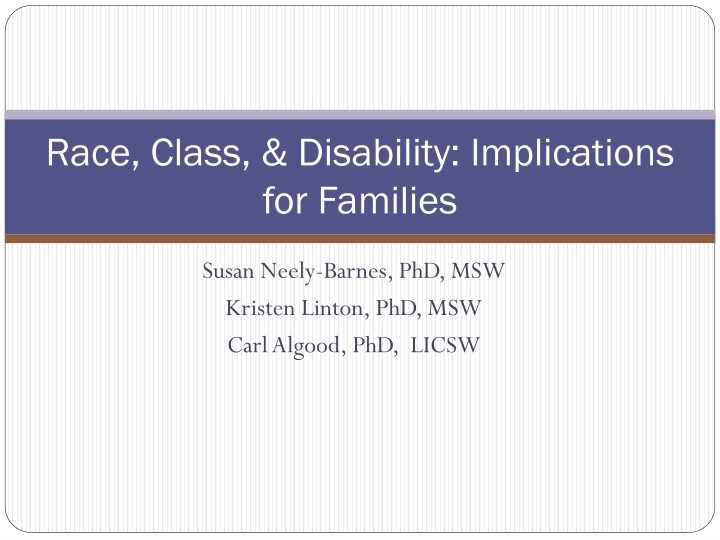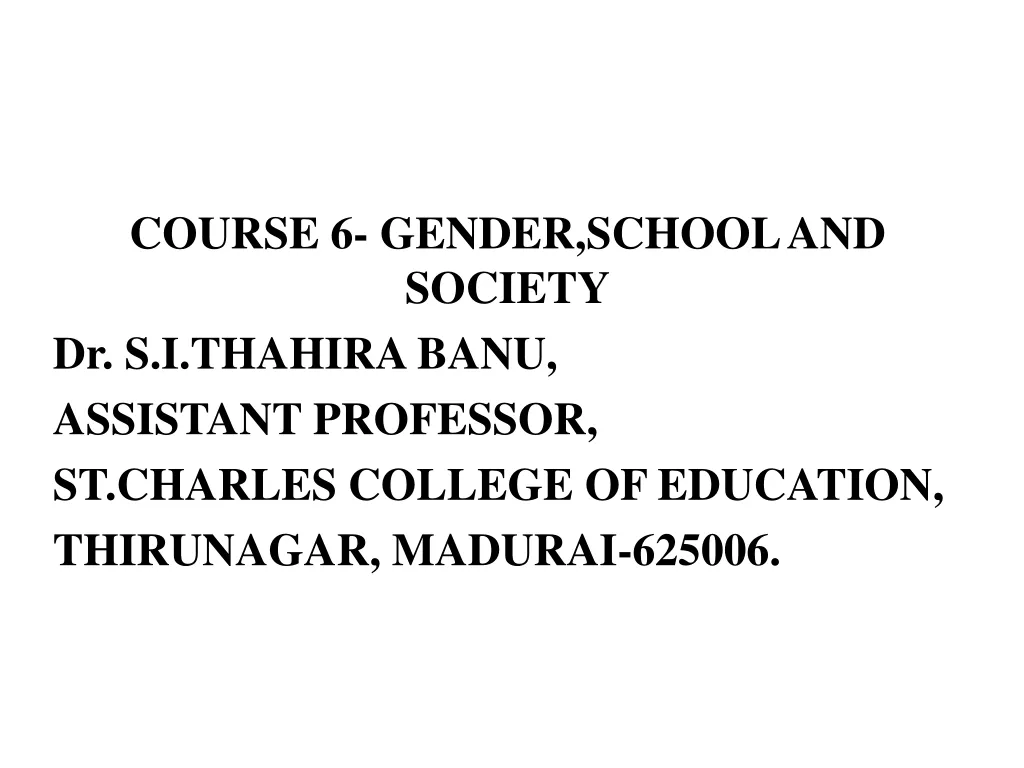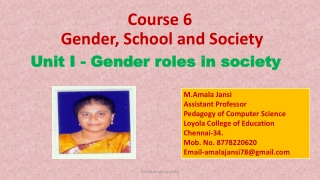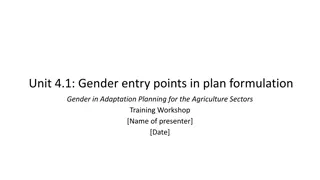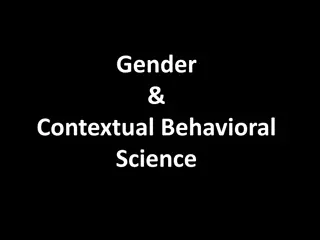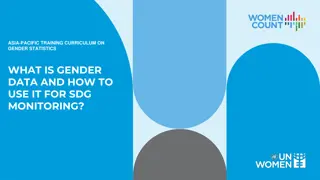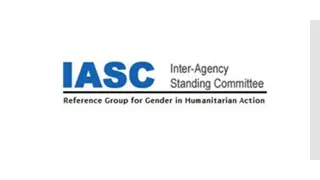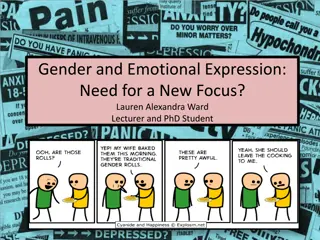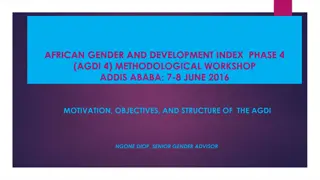COSATU Gender Review: Statistical Insights & Challenges
This presentation delves into statistical aspects of a gender review report conducted by COSATU, focusing on data analysis from 1985 to 2021. It covers gender and employment trends, women's leadership statistics, and survey findings from COSATU affiliates and provinces. The objectives include evaluating gender equality achievements, identifying gaps, and assessing policy implementation challenges over time.
Download Presentation

Please find below an Image/Link to download the presentation.
The content on the website is provided AS IS for your information and personal use only. It may not be sold, licensed, or shared on other websites without obtaining consent from the author.If you encounter any issues during the download, it is possible that the publisher has removed the file from their server.
You are allowed to download the files provided on this website for personal or commercial use, subject to the condition that they are used lawfully. All files are the property of their respective owners.
The content on the website is provided AS IS for your information and personal use only. It may not be sold, licensed, or shared on other websites without obtaining consent from the author.
E N D
Presentation Transcript
Race, Class, & Disability: Implications for Families Susan Neely-Barnes, PhD, MSW Kristen Linton, PhD, MSW Carl Algood, PhD, LICSW
Race, Class, and Disability Approximately 18.7% of the US population has a disability (Brault, 2012). Disability is experience disability across race and class. African Americans have a higher disability rate than other racial ethnic groups (20.7%) (Brault, 2012). People with disabilities are less likely to be employed and more likely to experience persistent poverty, particularly when their disability is classified as severe (Brault, 2012).
Purpose of the Presentation Review literature on educational disparities, health disparities, and family implications. Discuss gaps in current literature on the intersection of race, class, and disability. Discuss ways to infuse knowledge about this intersection in social work education. Explore new directions for social work research.
Diagnostic Disparities Over representation of African American/American Indian children in special education has been well-documented in prior literature However, some studies have found opposite results (Hibel, Farkas, & Morgan, 2010; Morgan, Farkas, Hillemeier, & Maczuga, 2014). Attending a school with high levels of achievement increases likelihood of special education identification (Hibel, Farkas, & Morgan).
Intersection of Diagnosis & Race Compared to white children: Intellectual disability (mental retardation) more likely to be diagnosed in African American and American Indian children. American Indian children more likely to be diagnosed with TBI or multiple disabilities. Latino, Native American, and Asian/PI children less likely to be diagnosed with autism or other health impairment. (Sullivan & Artiles, 2011).
Educational Disparities Graduation rates for African-American students with disabilities are substantially lower than rates for white or Asian/Pacific Islander students (Boone & King-Berry, 2007). African-American students are more likely to be tracked into segregated special education schools and classrooms (Boone & King-Berry, 2007).
Early Intervention Disparities Disproportional representation not found in early intervention services (Morgan, Farkas, Hillemeier, & Maczuga, 2014; Morrier & Gallagher, 2012).
Information Disparities Families from culturally diverse backgrounds struggle more with accessing the IEP process (Jung, 2011; Kalyanpur, Harry, & Skrtic, 2000). Most parent materials written by school districts are written at very high reading levels (Fitzgerald & Watkins, 2006).
English Language Learners & Disparities Families who do not speak English have a particularly difficult time accessing information about special education processes (Lasky & Karge, 2011). Students who are English language learners are over- represented in special education (Sullivan, 2011).
RtI & the Future of Special Education Response-to-Intervention (RtI) is being implemented across the nation. What is RtI? Continuous assessment and monitoring of student progress. Placement into one of three tiers: Tier One: traditional services Tier Two: group intervention Tier Three: one-on-one/intensive intervention/referral to special education Important question: Will students of color and low income students have differential access to services under RtI?
Common Core & Special Education It has been well documented that students from the inner city and rural areas (Roscigno, Tomaskovic-Devey, Crowley, 2006) and students of color (Landon-Billings, 2006) experience achievement gaps. What impact will the new Common Core curriculum have on the achievement gap? What impact will the Common Core curriculum have on students with disabilities?
Definition Health status disparities are variations in rates of disease occurrence and disabilities between socioeconomic and/or geographically defined population groups Healthcare disparities refer to differences in access to or availability of facilities and services. (NIH, 2014)
Life Expectancy People with Intellectual Disabilities (Patja, 2000) People with severe and profound ID decreased life lost by 20% compared to general population Epilepsy, hearing impairments, and institutional care increased the relative risk of death for people with all levels of ID People with Autism(Mouridsen, 2008) Relative risk of death is nearly 2x that of the general population People with Cerebral Palsy (Brooks, 2014) Median life expectancy 17.1 years (general population = 78.4) 50% of 4-year olds with CP and limited motor function live until age 10
Obesity Adolescents with Down s Syndrome (Rimmer, 2010) 2-3x more likely to be obese than general population People with Intellectual Disability (Winter, 2012) Statistically significantly more likely to be obese (26%) than general population (10%) Women, those with Down syndrome, higher age, less severe ID, autism, people who could eat independently, prepared meals and bought groceries independently, people with physical inactivity and use of atypical antipsychotics (olanzapine, risperidone and quetiapine) were significantly more at risk of being overweight or obese
Diabetes People with ID (n = 980; Winter, 2012) 53% experienced hypertension Among those, 50% had never received a diagnosis prior to the study Management of Diabetes among People with ID (Cardol, 2012) Interviews with people with ID found that they had many unanswered questions, yet did not dare ask questions during their annual checkups Research among General Population shows Lack of Knowledge Stroke study in Hawaii (Linton, 2014)
Accessing Health Care People with physical disabilities (Horner-Jonson, 2014) More likely than people with cognitive disabilities to delay or forgo medical care Children with Autism (Parish, 2012) Among children with autism and other developmental disabilities (N = 4,414) Latino children consistently had worse health care access, utilization, and quality than White children. Health care quality (provider does not spend enough time with child, provider is not culturally sensitive, and provider does not make parent feel like a partner) were significant mediators of the relationship between ethnicity and utilization.
Challenges to Accessing Health Care Physicians Physicians reported feeling a lack of confidence, compounded by anxiety related to difficult behaviors and a lack of context or frame of reference for patients with intellectual disability (Wilkonson, 2012) Among physicians that reported providing services for people with ASD, 55% reported receiving no training on ASD; 54.7% of them reported that patients with ASD did not follow their medical recommendations (Bruder, 2012)
Role of Social Workers Preventer- early identification of health issues is key Annual health checks are statistically significantly associated with diagnosis of previously undetected health issues (Robertson, 2011) Mediator- support communication between client and health care provider Educator- educate clients about health conditions and healthcare providers about needs of clients with disabilities
Implications for Families Raising a child with a developmental disability significantly impacts family functioning and hence the quality of life for the family. (Davis & Gavidia-Payne, 2009 ; Dunlap & Hollinsworth, 1977). Minority populations face challenges of raising children with disabilities in all areas of their lives as they assume the stressors of care giving. Lack of literature on minority families raising children with disabilities has compounded the problem. Race in conjunction with disability results in satisfaction of life that is at a lower level( Smith & Alston (2009).
Lack of Family Resources Minorities with disabilities in the United States have fewer resources and less knowledge and understanding of available resources than others (Gupta, 2007). While factors such as health, learning opportunities and jobs are significant for a satisfied life, they are experienced at different levels for diverse members of society(Smith & Alston (2009). Families of children who have increase personal care, medical and therapeutic service needs were found to have increased financial concerns, as well as problems with work and sleep (Neely-Barnes & Marcenko, 2004).
Impact of Class on Families When compared to families of children without disabilities, families of children with disabilities face additional financial burdens, such as increased therapy costs, specialized day care and adapting the home environment (Parish & Cloud, 2006). Middle-class families with a child with an intellectual disability are more likely to use available services than are lower class and non-white families (Daly, Jennings, Beckett and Leashore, 1995). Parents who chose to keep their children at home identified social class and social and psychological stressors as important determinants. Stressors ranged from the severity and the nature of the disability to limited financial resources (Daly, Jennings, Beckett and Leashore, 1995).
Positive Family Adjustment In their study of autism, Manning, Wainwright, & Bennett (2011) concluded that while families proclaimed large amount of stress was prevalent, their family functioning was with in normal limits. Family adjustment to disability in childhood is linked to how strong the mothers coping is from a psychological perspective. This means they have the capability to visualize outcomes that are positive related to the disability, including higher levels of emotions that are positive in areas such as activities of daily living (Trute, Benzies, Worthington, Reddon & Moore, 2010).
Impact on African Americans Studies report that African American families show greater adjustment and coping capacities to stressors such as financial insecurity, availability of and access to necessary supports and services, and the severity and type of the disability (Darling & Gallagher, 2004 ;Dunlap & Hollinsworth, 1977) Other studies concluded that African American families raising children with disabilities are struggling with the challenges they face in these situations (Ebersole & Kapp, 2007) Strong kinship bonds, religious connections, and extended family network remain a current relevant source of social support for the African American family. (Taylor, Seaton & Dominguez, 2008; Crewe & Wilson, 2007; Gourdine, 2007)
Impact of Family Structure Positive relationships were found in the family structure where the person with a disability had non-disabled siblings (Stoneman, 2005; Dykens, 2005). Siblings of persons with disabilities taught them, the value of what is important in life and exhibited a caring, protective attitude toward the sibling with the disability (Dykens, 2005). Children with developmental disabilities stood a greater chance of not living in a household of a married couple than children without disabilities (Parish, Rose, Grinstein-Weiss, Richman, & Andrews, 2008)
Impact of Family Structure The authors researched the adjustment of families to raising a child with a disability where there were one or two parents and siblings in the household (Trute, Hiebert-Murphy & Levene, 2007; Glidden, Billings & Jobe, 2006) The research pointed to greater stress and depression with the mother as compared to the father. This might be explained based on the fact that the mother is the primary caregiver role.
Role of Social Workers Social workers must be knowledgeable of the needs of children with disabilities and their families to fulfill their ethical obligations to provide culturally competent, family- centered services(Parish and Cloud, 2006) Social workers and other health care professionals can help improve the delivery of and access to family supports through effective outreach, education, service coordination and advocacy. Social workers must seize the limitless opportunities the field of disabilities offers as leaders, researchers, advocates and practitioners (Gourdine and Saunders, 2002)
Discussion What are some possible future directions for social work research around race, class, & disability? How can we do better with educating our students about these disparities?
Discussion How can as social workers enhance family functioning, coping capacities and overall quality of life of minority families and those on the lower socio- economic scale who are raising children with disabilities? What roles can social workers perform to insure that families continue to receive services under federal legislation, such as Developmental Disabilities Bill of Rights Act 2000 (DD ACT), the Americans with Disability Act of 1990 (ADA), and the Individual Disabilities Education Act 2004 (IDEA)?
References Axelrod, D. A., Millman, D., & Abecassis, M. M. (2010). US health care reform and transplantation, Part II: impact on the public sector and novel health care delivery systems. American Journal of Transplantation, 10(10), 2203-2207. Brault, M. W. (2012, July). Americans with disabilities: 2010. United States Bureau of Census. Retrieved August 26, 2014 from: http://www.census.gov/prod/2012pubs/p70-131.pdf Boone, R. S. & King-Berry, A. (2007). African American students with disabilities: Beneficiaries of the legacy? The Journal of Negro Education, 76, 334-345. Davis, K., & Gavida-Payne, S. (2009). The impact of child, family, and professional support characteristic s on the quality of life in families of young children with disabilities. Journal of Intellectual & Developmental Disability, 34(2), 153-162.
References Daly, A., Jennings, J., Beckett, J. O., & Leashore, B. R. (1995). Effective coping strategies of African Americans. Social Work, 40(2), 240-248. Darling, S. M., & Gallagher, P. (2004). Needs of and support for African Americans and European American caregivers of young children with special needs in urban and rural settings. Topics in Early Childhood Special Education, 24(2), 284-293. Darling, S. M., & Gallagher, P. (2004). Needs of and support for African Americans and European American caregivers of young children with special needs in urban and rural settings. Topics in Early Childhood Special Education, 24(2), 284-293. Dunlap W. R., & Hollinsworth, J. S. (1977). How does a handicapped child affect the family? Implications for practitioners. The Family Coordinator, 26(3), 286-293.
References Dyken, E. M. (2005). Happiness, well-being, and character strengths: Outcomes for families and siblings of persons with mental retardation. American Association on Mental Retardation, 43(5), 360-364. Dyson, L. L. (1996). The experience of families of children with learning disabilities: Parental stress, family functioning, and sibling self- concept. Journal of Learning Disabilities. 3(29), 280-286. Ebersole, J. L., & Kapp, S. A. (2007). Stemming the tide of overrepresentation: Ensuring accurate certification of African American students in programs for the mentally retarded. School Social Work Journal, 31(2), 1-16. Fitzgerald, J. L. (2006). Parents rights in special education: The readability of procedural safeguards. Exceptional Children, 72, 497- 510.
References Gourdine, R. M. (2007). Child only kinship care cases: The unintended consequences of TANF policies for families who have health problems and disabilities. Journal of Health & Social Policy, 22(3/4), 44-64. Gourdine, R. M., & Sanders, T. (2002). Missed opportunities and unlimited possibilities: Teaching disability content in schools of social work. In S. D. Miller, (Ed.). Disability and the Black Community. Albany, NY: The Haworth Press Gupta, V. B. (2007). Comparison of parenting stress in different developmental disabilities. Journal of Developmental and Physical Disabilities, 19(4), 417-425, doi:10.1007/s10882-007-9060. Heykyung, O., & Lee, E. (2009). Caregiver Burden and Social Support among Mothers Raising Children with Developmental Disabilities in South Korea. International Journal of Disability, Development & Education, 56(2), 149-167.
References Hibel, J., Farkas, G., & Morgan, P. L. (2010). Who is placed into special education? Sociology of Education, 83, 312-332. Ing, M., Vento, M., Nakagawa, K., & Linton, K. F. (unpublished). Stroke knowledge, education, and transportation challenges among survivors of Intracerebral Hemorrhage stroke and their caregivers. Jung, A. W. (2011, Spring). Individualized Education Programs (IEPs) and barriers for parents from culturally and linguistically diverse backgrounds. Multicultural Education, 21-25. Kalyanpur, M., Harry, B., & Skrtic, T. (2000). Equity and advocacy expectations of culturally diverse families participation. International Journal of Disability, Development, and Education, 47, 119-136. Ladson-Billings, G. (2006). From the achievement gap to the education debt: Understanding achievement in U.S. schools. Educational Researcher, 35, 3-12.
References Manning, M. M., Wainwright, L., & Bennett, J. (2011). The Double ABCX Model of Adaptation in Racially Diverse Families with a School-Age Child with Autism. Journal Of Autism & Developmental Disorders, 41(3), 320-331. Morgan, P. L., Garkas, G., Hillemeier, M. M., & Maczuga, S. (2012). Are minority children disproportionally represented in early intervention and early childhood special education? Educational Research, 41, 339-351. Morrier, M. J. & Gallagher, P. A. (2012). Racial disparities in preschool special education eligibility for five Southern states. The Journal of Special Education, 46, 152-169. Parish, S., Rose, R., Grinatein-Weiss, M., Richman, E., & Andrews, M. (2008). Material hardship in US families raising children with disabilities. Exceptional Children, 75(1), 71-92. Retrieved from Academic Search Premier database.
References Reichard, A., Stolzle, H., & Fox, M. H. (2011). Health disparities among adults with physical disabilities or cognitive limitations compared to individuals with no disabilities in the United States. Disability and Health Journal, 4(2), 59-67. Roscigno, V. J., Tomaskovic-Devey, D., & Crowley, M. (2006). Education and the inequalities of place. Social Forces, 84, 2121-2145. Smith, D. L., & Alston, R. J. (2009). The Relationship of Race and Disability to Life Satisfaction in the United States. Journal of Rehabilitation, 75(1), 3-9. Stoneman, Z. (2005). Siblings of children with disabilities: Research themes. Mental Retardation, 5, 339-350. Sullivan, A. L. (2011). Disproportionality in special education identification and placement of English language learners. Exceptional Children, 77, 317-334.
References Taylor, R., Seaton, E., & Dominguez, A. (2008). Kinship support, family relations, and psychological adjustment among low-income African American mothers and adolescents. Journal of Research on Adolescence, 18(1), 1-22. Trute, T. Benzies, K. M. , Worthington, C., Reddon J.R., & Moore, M. (2010). Accentuate the positive to mitigate the negative: Mother psychological coping resources and family adjustment in childhood disability. Journal of Intellectual & Developmental Disability, 35(1), 36-43. Trute, B., Hiebert-Murphy, D., & Levine, K. (2007). Parental appraisal of the family impact of childhood developmental disability: Times of sadness and times of joy. Journal of Intellectual & Developmental Disability, 32(1), 1-9. Retrieved May 5, 2009, doi:10.1080/13668250601146753.
References Taylor, R., Seaton, E., & Dominguez, A. (2008). Kinship support, family relations, and psychological adjustment among low-income African American mothers and adolescents. Journal of Research on Adolescence, 18(1), 1-22. Trute, T. Benzies, K. M. , Worthington, C., Reddon J.R., & Moore, M. (2010). Accentuate the positive to mitigate the negative: Mother psychological coping resources and family adjustment in childhood disability. Journal of Intellectual & Developmental Disability, 35(1), 36-43. Trute, B., Hiebert-Murphy, D., & Levine, K. (2007). Parental appraisal of the family impact of childhood developmental disability: Times of sadness and times of joy. Journal of Intellectual & Developmental Disability, 32(1), 1-9. Retrieved May 5, 2009, doi:10.1080/13668250601146753.
